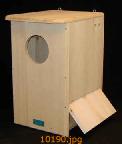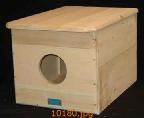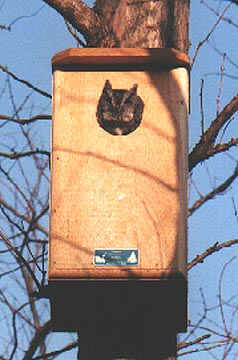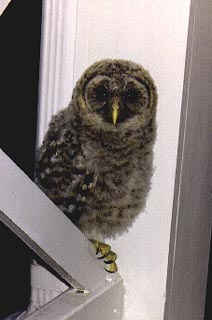
   |
 |
|
|
|
All owls have specially designed eyes, ears, and wings
to enable them to capture their prey.
Their
eyes are large and on the front of their faces, giving them binocular vision and
fine depth perception. They have a large concentration of rods on their
retinas, but they see little color. Their eyes are ten times as
light-sensitive as human eyes, but they are short-sighted so they hunt near the
ground. Their eyes are so large that there is little room in their skulls
for eye muscles. Thus an owl turns its head, sometimes as much as 270
degrees, rather than its eyes, to follow a moving object.
Owl ears are located on the sides of the "facial disks," those round feather arrangements, and give owls the most highly developed sense of hearing of all birds. The facial feathers help to amplify and channel sounds to their ears. Generally one ear is larger than the other and slightly above or below, so the owl can pinpoint the location of a sound. It can hear a mouse or a cricket in the grass below! The owl's feathers are silent in flight. The wings have downy fringes along the stiff flight feathers which muffle sound as the owl approaches its prey. Owls swallow their prey whole. Then later they cough up a "pellet" of bones and fur. Owls can often be found in the woods by locating these pellets on the ground, or by finding their white droppings, called "whitewash."
|
 Heartwood Screech Owl Joy Box Birdhouse
Heartwood Screech Owl Joy Box Birdhouse
John James Audubon did some of his most famous bird drawings as he explored on foot along the Natchez Trace, which happens to be located near Star, Mississippi, where we design and make all our Heartwood homes. While birding has come a long way since Audubon's time, today with our four-season nesting boxes and basic homes, you don't need to go to anywhere to enjoy all manner of wonderful bird life flocking to your door. Discreet complements to any landscape, these hardy havens are convenient, long lasting and beautiful-the picture perfect start to your life in birding! Season after season, this delightful nesting box is a joy to behold and a breeze to maintain thanks to easy twist latch and slide-front panel that also inverts for winter roosting. So easy to use, so easy to love, it turns birding into child's play! Rugged construction features 13/16" solid cypress and headed ring shank stainless steel nails. Dimensions: 9 ½" x 13" x 21"; 3" hole  |
 Coveside Barred Owl House
Coveside Barred Owl House
The Barred Owl is slightly larger than a barn owl and sounds like a typical "hoot owl." This house can be mounted high in a tree with the two metal hangers. Bottom of side opens for ease in cleaning. RANGE: Resides from British Columbia east to Nova Scotia, and south to northern California, and to Texas and Florida. HABITAT: Lives in low, wet woods and swampy forests. (25"h x 14-1/4"w x 19"d) |
 Coveside Common Barn Owl House
Coveside Common Barn Owl House
The Barn Owl with its heart-shaped face is 18" high with a wing span of 44". These highly valued, rodent-eaters will have an ideal residence in this very large house which comes with wood chips. RANGE: Resides from southern British Columbia east through the Dakotas and Michigan to southern New England, and southward. HABITAT: Lives in open country, forest edges and clearings, cultivated areas, cities and farms. (17"h x 20"w x 26"d) |
 Coveside Screech Saw-Whet Owl House
Coveside Screech Saw-Whet Owl House
Saw-whet owls and screech owls have tough competition from other birds because they are so small. This house provides a perfect cavity, complete with wood chips for nesting material. RANGE: Breeds from southeastern Alaska east across central Canada to Nova Scotia and south to southern California, Arizona, Illinois, North Carolina (in mountains) and Connecticut. Winters in breeding range and south to Arkansas and North Carolina. HABITAT: Nests in deep woods, preferably near swamps. Likes coniferous woods and evergreen thickets in parks and gardens. (17-3/4"h x 9-1/4"w x 11"d) |
|
Ads by Google |

Home
Page |
Product Review Page | Help
 Woodside Gardens
The Registry of Nature Habitats
Woodside Gardens
The Registry of Nature Habitats 
 1999 -
1999 -
All Rights Reserved
Last Updated:

